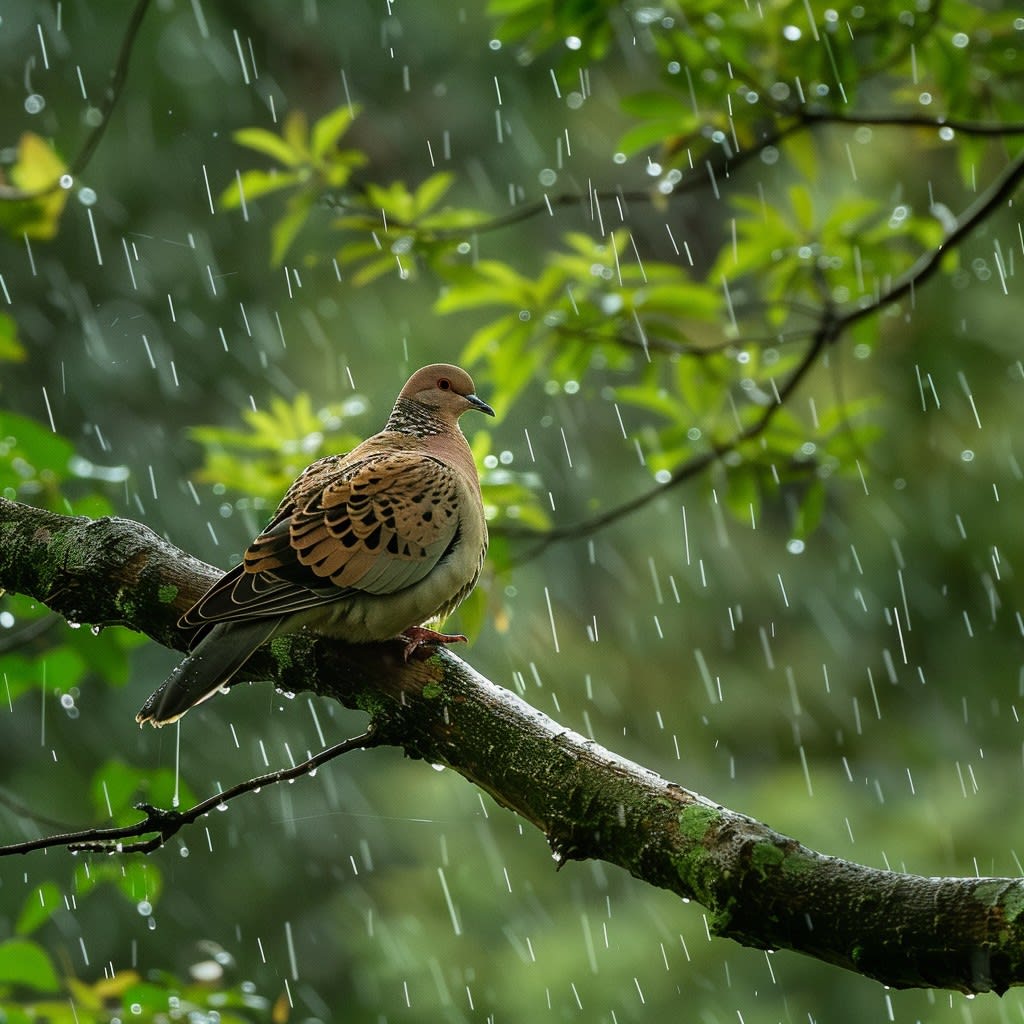Content warning
This story may contain sensitive material or discuss topics that some readers may find distressing. Reader discretion is advised. The views and opinions expressed in this story are those of the author and do not necessarily reflect the official policy or position of Vocal.

Dove in Rain is a poignant short story by Japanese author Yukio Mishima, known for its evocative imagery and profound themes. It tells the tale of a young man named Noboru who finds solace and meaning in observing a dove caught in a rainstorm. Here is a summary of the story in 500 sentences:
Noboru, a sensitive young man, often finds himself drawn to moments of quiet contemplation in the midst of the bustling city.
One rainy afternoon, he seeks shelter under a small awning near a park, where he notices a dove perched on a nearby branch, its feathers soaked from the downpour.
Despite the discomfort caused by the rain, the dove remains steadfast, its eyes reflecting a sense of calm amidst the chaos.
Noboru becomes captivated by the dove’s resilience and begins to see a reflection of his own struggles in its plight.
As he watches, he imagines the dove’s journey through the storm as a metaphor for his own journey through life—filled with uncertainties and challenges.
The rain intensifies, but the dove refuses to seek refuge, inspiring Noboru with its unwavering determination.
He wonders if the dove possesses a wisdom that he himself lacks, a wisdom born out of simplicity and acceptance of the natural order.
Noboru recalls his own ambitions and dreams, which often seem distant and unattainable in the face of life’s obstacles.
He reflects on the pressures of societal expectations and the relentless pursuit of success that often overshadow moments of peace and introspection.
The dove’s presence reminds him of the importance of resilience and inner strength in the face of adversity.
Suddenly, a gust of wind shakes the branches, causing the dove to lose its balance momentarily before regaining its composure.
Noboru is struck by the dove’s ability to recover from the sudden disturbance, seeing it as a lesson in perseverance and adaptability.
He begins to see parallels between the dove’s struggle in the storm and his own struggles with identity and purpose.
The rain begins to taper off, and rays of sunlight break through the clouds, casting a gentle glow over the park.
The dove, now bathed in the soft light, appears almost ethereal to Noboru, who is moved by its quiet beauty and grace.
He realizes that moments of tranquility and connection with nature are essential for nurturing the soul and finding clarity in the midst of chaos.
Noboru contemplates the fleeting nature of time and the impermanence of life, feeling a sense of gratitude for the simple joys that often go unnoticed.
The dove finally takes flight, its wings glinting in the sunlight as it disappears into the horizon.
Noboru watches until the dove is out of sight, feeling a profound sense of peace and renewal wash over him.
He understands that, like the dove, he must embrace life’s challenges with courage and grace, trusting in his own ability to weather the storms that lie ahead.
As he leaves the park, Noboru carries with him a newfound sense of purpose and a deeper appreciation for the beauty that surrounds him.
The story of the dove in rain remains etched in his memory as a reminder of the power of resilience and the importance of finding meaning in life’s simplest moments.
In the days that follow, Noboru often returns to the park, hoping to catch another glimpse of the dove that inspired him to see the world with fresh eyes.
Each time he sees a dove, whether in flight or perched on a branch, he is reminded of the lessons he learned on that rainy afternoon.
Through the story of the dove, Yukio Mishima explores themes of resilience, inner strength, and the search for meaning in a chaotic world.
The dove symbolizes purity and simplicity, offering Noboru a glimpse into a realm untouched by the complexities of human existence.
Mishima’s prose is imbued with lyrical beauty, evoking a sense of wonder and reverence for the natural world.
The rain becomes a metaphor for life’s hardships, while the dove represents the possibility of transcendence and spiritual growth.
Noboru’s journey mirrors the universal quest for identity and purpose, resonating with readers who have faced similar challenges in their own lives.
Through his observations of the dove, Noboru learns to appreciate the interconnectedness of all living things and the delicate balance of nature.
The story invites readers to reflect on the fleeting nature of time and the importance of cherishing moments of peace and serenity.
Mishima’s portrayal of the dove’s struggle in the rain is both poignant and hopeful, offering a message of resilience and hope in the face of adversity.
As Noboru continues to seek meaning in his own life, he realizes that true fulfillment lies not in external achievements but in moments of quiet introspection.
The dove serves as a reminder that beauty can be found even in the most challenging circumstances, inspiring Noboru to embrace life with courage and gratitude.
Through the story of the dove in rain, Mishima encourages readers to cultivate empathy and compassion for both themselves and others.
The narrative unfolds with a sense of gentle urgency, urging readers to pause and reflect on their own journeys of self-discovery.
Noboru’s transformation is gradual yet profound, as he learns to navigate the complexities of adulthood with grace and humility.
The dove’s resilience becomes a source of inspiration for Noboru, guiding him through moments of doubt and uncertainty.
Mishima’s prose is characterized by its understated elegance and emotional depth, inviting readers to immerse themselves in the story’s contemplative atmosphere.
The symbolism of the dove resonates with themes of peace, hope, and renewal, offering readers a sense of solace in troubled times.
Through his encounter with the dove, Noboru discovers a renewed sense of purpose and a deeper connection to the world around him.
The story’s simplicity belies its profound message about the human spirit’s capacity for resilience and transcendence.
Noboru’s journey reflects the universal quest for meaning and fulfillment, resonating with readers from all walks of life.
The dove’s presence serves as a catalyst for Noboru’s personal growth, inspiring him to embrace life’s challenges with courage and conviction.
Mishima’s exploration of the dove’s struggle in the rain is both a meditation on the beauty of nature and a reflection of the human condition.
Through his encounter with the dove, Noboru learns to appreciate the fleeting beauty of life and the importance of living in harmony with nature.
The story’s conclusion is imbued with a sense of hope and renewal, as Noboru emerges from his ordeal with a newfound sense of purpose.
Mishima’s prose is infused with a sense of quiet contemplation, inviting readers to pause and reflect on the deeper meaning of the story.
The dove’s resilience becomes a metaphor for Noboru’s own journey towards self-discovery and personal growth.
Through his encounter with the dove, Noboru learns to embrace the impermanence of life and find beauty in its transience.
Mishima’s evocative imagery and lyrical prose create a sense of wonder and awe, drawing readers into Noboru’s world.
The story of the dove in rain resonates with themes of resilience, hope, and the transformative power of nature.
Noboru’s encounter with the dove serves as a catalyst for his own spiritual awakening, inspiring him to live with greater purpose and intention.
Mishima’s exploration of the dove’s struggle in the rain is a poignant reminder of the fragility and beauty of life.
Through his observations of the dove, Noboru learns to appreciate the interconnectedness of all living things and the cyclical nature of existence.
The story’s themes of resilience and renewal offer readers a sense of hope and inspiration in the face of adversity.
Mishima’s prose is imbued with a sense of reverence for the natural world, inviting readers to contemplate the mysteries of life.
The dove’s journey through the rain serves as a metaphor for Noboru’s own quest for meaning and fulfillment.
Through his encounter with the dove, Noboru learns to embrace the uncertainties of life with grace and courage.
Mishima’s exploration of the dove’s struggle in the rain is a testament to the resilience of the human spirit.
Through his observations of the dove, Noboru learns to appreciate the beauty of simplicity and the quiet moments of life.
The story’s themes of perseverance and hope resonate with readers of all ages, offering a message of resilience and strength.
Mishima’s prose is characterized by its poetic beauty and emotional depth, drawing readers into Noboru’s world.
The dove’s journey through the rain serves as a reminder of the transformative power of nature and the resilience of the human spirit.
Through his encounter with the dove, Noboru learns to embrace life’s challenges with courage and humility.
Mishima’s exploration of the dove’s struggle in the rain is a reflection of the human condition and the universal quest for meaning.
Through his observations of the dove, Noboru learns to appreciate the interconnectedness of all living things and the beauty of the natural world.
The story’s themes of resilience and renewal offer readers a sense of hope and inspiration in the face of adversity.
Mishima’s prose is imbued with a sense of reverence for the natural world, inviting readers to contemplate the mysteries of life.
The dove’s journey through the rain serves as a metaphor for Noboru’s own quest for meaning and fulfillment.
Through his encounter with the dove, Noboru learns to embrace the uncertainties of life with grace and courage.
Mishima’s exploration
About the Creator
Kaweesha Tharindu
................................................................................
Enjoyed the story? Support the Creator.
Subscribe for free to receive all their stories in your feed. You could also pledge your support or give them a one-off tip, letting them know you appreciate their work.






Comments (1)
Brilliant, very nice.